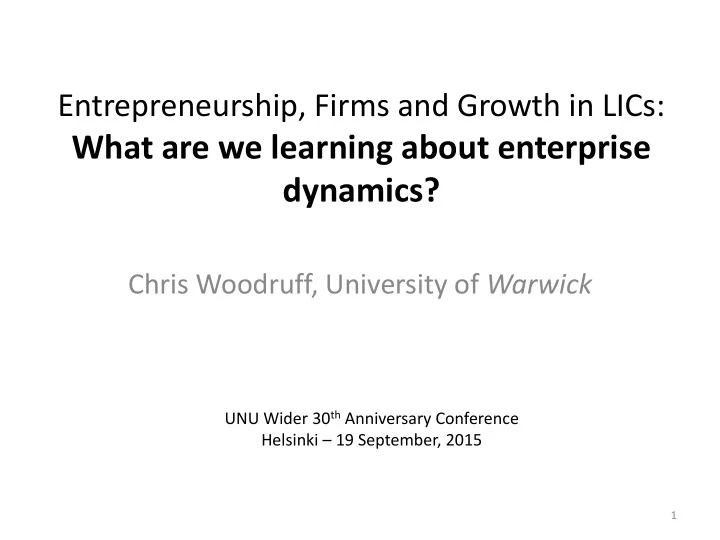

Entrepreneurship, Firms and Growth in LICs: What are we learning about enterprise dynamics? Chris Woodruff, University of Warwick UNU Wider 30 th Anniversary Conference Helsinki – 19 September, 2015 1
Own account vs. Employers 2 Source: ILO
What do we know about moving down and to the right on that graph? • I would say…not very much…at least yet • Where do large employers come from? – Are large firms just born large, or can they be built? – Are exports necessary for large private firms? – Do the micro- ever become medium? (or even small?) 3
What constrains firm owners from hiring and growing? • A, K, L: Likely all three. • I will focus on capital constraints to capital, given the limited time. – At a macro level, evidence of serious misallocation: Banerjee and Duflo’s 2005 handbook chapter, Hsieh and Klenow 2008 QJE – Constraints on credit, particularly among the poor, have been recongnized for a long time. • But until recently, convincing evidence has been wanting. 4
What does the more recent evidence say? A puzzle: - From several field experiments: Evidence that returns to marginal investments of capital are very high in very small enterprises – Sri Lanka (DMW 2008, 2009, 2012); Ghana (FMQW 2011); Mexico (MW, 2008) And yet: - From several field experiments: Evidence that effect of microfinance on enterprise growth is very limited – AEJ-Applied Jan 2015 for India, Mexico, Bosnia, Ethiopia, Mongolia. 5
A puzzle is a good result! • The puzzle stimulates thinking about why these differences are there – FPPR 2015: Need to start repaying immediately is a constraint to risk-taking. Solution? 2-month grace period. • Good news: It works! Borrowers take more risks, earn much higher returns • Bad news: Default rates increase enough that it is unprofitable for MFIs – New work underway on other ways to overcome the initial repayment problem • This is an area where the new experimental techniques are moving us forward 6
But capital is the easy one • One form is sufficient: Cash – Okay, there could be other issues. Commitment issues, lumpy investments, etc. • But think about the “A” in AKL production functions: Evaluating training programs. – MW (2012) review 16 experiments on microenterprise training. The punchline? – We haven’t learned much, if anything. • Variance in target entrepreneurs; different training material; different sectors, etc. 7
And microenterprises are the easy ones • Understanding dynamics in larger firms is much more challenging. – Fewer in number – More challenging to work with • Opportunities in administrative data – Administrative records in firms • IT costs have fallen faster than salaries of analysts – Government data exists in many countries, but access is very personalized. So far, access is slow and sporadic. 8
And microenterprises are the easy ones • But we are beginning to see progress on larger firms as well, from a variety of approaches – Sutton’s enterprise maps – Bloom et al management practices – Deep dives into specific industries, combining theory and experiments: Atkin et al (soccer balls, rugs); Keniston (bricks); Macchiavello and Morjaria (coffee); Woodruff et al (garments), etc. • In common with other topics, an evolution of research methods, from theory-intensive work observational data-driven work experimental work. – And more recently, some resurgence in theory, but often bundled with experiments. 9
Concluding thoughts on the bigger picture • I recall the time when Ronald McKinnon was ridiculed for suggesting that weak capital markets were a major source of under-development. • For the first half of the last 30 years, the (formal, domestic) private sector has hardly been on the development agenda. • I expect at UNU- WIDER’s 50th anniversary, the private sector will play a more prominent role. 10
Recommend
More recommend